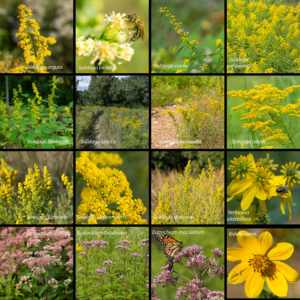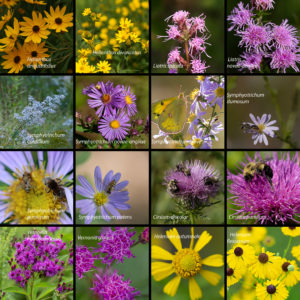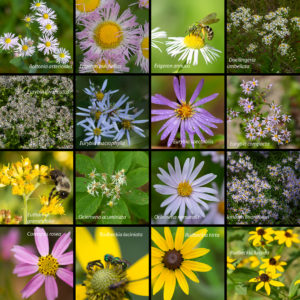Written and Photographed by Uli Lorimer
Pollinator friendly is certainly a buzz word these days and for good reason. Recent studies have shown significant declines in both insect and bird diversity, two groups intimately intertwined with one another. Both birds and insects are being impacted by climate change, habitat loss and fragmentation, and invasive species. This reality makes our choices in the garden that much more crucial.
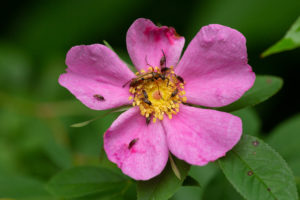
Rosa Palustris bloom with flower longhorn and pollinator
But gardeners do not have access to all of the information needed to make choices that explicitly support pollinators of all kinds. Perhaps we should begin by asking what makes a plant pollinator friendly? Is it the color of the blooms? Is it the shape of the flower? Is it because a honey bee or bumble bee visits them? Is it the nutritional value of nectar and pollen which keep them coming back for more? Lastly, is it because the blossoms coincide with the life cycle of the pollinator?
The answer is yes to all of these qualifiers but with some caveats. There is so much more to the interactions between plants and insects. A Rosa carolina blossom is bowl shaped and ready to party with all types of pollinators. Other plants, like our pink lady slipper, do not produce nectar at all and rely on subterfuge for pollination. Pollinators are lured into the slipper of the flower and can only exit by crawling past the stigma and pollinia, their stomachs empty having unwittingly done the orchid’s bidding. Yet another plant, Dodecatheon media (eastern shooting star), has poricidal anthers meaning pollinators must buzz or vibrate at just the correct frequency to shake out the pollen.
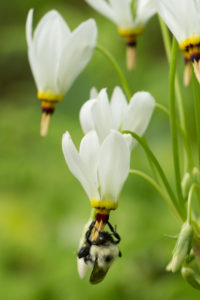
Dodecatheon meadia with a pollinator.
Generally speaking, pollinators fall into two categories, generalists and specialists. Specialists have evolved specific relationships with specific plant families, genera, and even species so much so that if that particular plant is missing from the landscape, the pollinator will also soon disappear. Generalists have an advantage as they are not picky about where to get their resources. From the plant’s perspective, the goal is seed production and a chance of passing on good genes to the next generation. Let us take bees as an example. Fifteen percent of the native bee species in the Northeast are specialists. Early flowering species like Claytonia virginica (Virginia spring beauty), Erythronium americanum (trout lily), and Salix sps (willows) are very? important for these specialists to thrive. At the other end of the season Symphyotrichum (asters) and Solidago (goldenrods), in all of their diversity, provide resources for generalists and specialist bees, but also for a multitude of other pollinators (think wasps, flies, beetles).
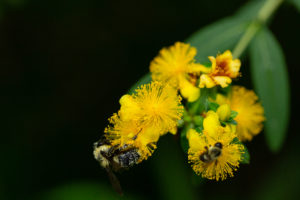
Hypericum prolificum with a pollinator.
The key to the survival of these imperiled pollinators is keeping as many diverse native species on the landscape as possible. However, finding appropriate native species can be challenging because the nursery industry is still mostly supplying what is pretty. The information regarding a given plant’s value to wildlife is entirely missing from the retail experience of plant shoppers. With more education and demand for more comprehensive labeling, home gardeners, designers, and landscape professionals can be sure to include native plant species that are supportive of imperiled and threatened pollinators. Jarrod Fowler has done extensive research on host plants for pollen specialist bees of the Eastern United States.
- Asteraceae Colleges. These are plants for specialist bees but the species will support generalists pollinators and many other organisms as well.
There are also ways to encourage a high level of insect diversity at home in the ways we manage our gardens. Plant as diversely as possible, with ecological function as the primary concern. Your garden will be beautiful and brimming with life. Avoid using any pesticides as the collateral damage of these chemicals is high. Lastly, learn to embrace a bit of wild or messy in your garden. This last point will be difficult for some as we have been browbeaten into thinking every aspect of our gardens must be controlled, tidy, and neat. This is not the way of nature. It is high time we began connecting the dots between plant diversity, insect diversity, human well-being, and the healthy ecosystem.
About the Author
Uli Lorimer is the Director of Horticulture at the Native Plant Trust. Uli’s background in horticulture goes back to high school when he worked for local nurseries and noticed that every company was selling the same types of plants. That led him to seek out work with botanical gardens that specialize in growing and displaying plant species not found in most gardens. Thus began his fascination with plant diversity. His position as Director of Horticulture at Native Plant Trust is an ideal fit. Uli holds degrees in botany and horticulture from the University of Delaware which led to positions with the U.S. National Arboretum in Washington D.C., Wave Hill in New York City, and the Brooklyn Botanic garden. During his 14 years with the Brooklyn Botanic Garden, Uli broadened his native plant knowledge and fascination with where and how native species grow in the wild.

